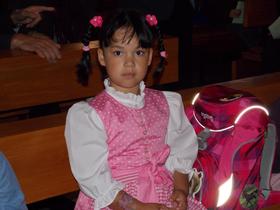Small class sizes work. In fact, small class sizes are one of the main reasons why you send your child to boarding school. Here are some reasons why small class sizes are so important.
1. There's nowhere to hide in a small class.
Imagine your child is in a large high school class of 30-35 students. She's not good at math. Most of the students in her class don't understand math and could care less about it. So your daughter hangs out in the back of the class, keeps quiet and tries to pay attention. The distractions and cutting up going on around her mitigate against any meaningful learning. Your daughter falls further and further behind in math. Sadly, public school class sizes are increasing as school districts struggle with budget deficits. Class sizes of 30-35 students are common.
Contrast that learning environment with 12-14 students seated around a Harkness Table in a boarding school. A Harkness Table is an oval table. The teacher sits at the table with his students. Immediately students are placed in a situation where they have no choice but to engage and interact with each other and with their teacher. A Harkness table creates a climate for learning.
This video discusses teaching in large versus small classes.
Implicit in the small teaching groups is a climate of tolerance. The views of each individual are expressed. Critical thinking skills are practiced and polished precisely because the small group allows time for that. Large groups make developing those skills a challenge. Drawing out each student in a large group is a challenge. Drawing out students in a small group is easy, effective, and expected. Your child will be noticed when she sits at a Harkness table. She will be helped when she needs help. She will be encouraged to express her point of view and to defend her beliefs. That develops self-confidence and poise as she progresses towards adulthood.
Small classes really involve students. Small classes surround students with attention and encouragement. Teachers provide attention and encouragement as part of how they guide students' learning. But the small group fosters sharing and even a sense of teamwork as concepts are explored in the give and take of discussion. Because students learn in different ways, the teacher can take all the time he needs to present the material being taught in a variety of ways appropriate to his small class of students. That is much more difficult to do with a large class.
2. You can actually teach when classes are small.
Very few teachers enjoy managing a large class. It's very difficult to do. Unfortunately, that's what you end up doing when confronted with a large class of students. It's not easy managing 25-35 students of any age in any situation. Behavior problems in a small class are the exception rather than the rule. Behavior problems in a large group of students of any age can quickly escalate out of control. The teacher often has several different achievement levels to work with. That's tricky enough to handle under the best of circumstances, but in a large class, it becomes a major challenge.
Students really do learn more when classes are small. They learn faster. They progress through the material more quickly. They soon develop the confidence to express their ideas and opinions without fear of scorn and retribution from their peers. Small classes help create a climate for learning. After all the students are there to learn. Listen to what this student thinks of being in a small class. Since teaching has so much to do with a teacher observing how a student learns and how he is retaining information, a small class allows a teacher to really observe closely and carefully monitor how individual students are doing. The quicker response makes for greater progress. Put another way, children learn more in a small class because the teacher can do more teaching and can assess the effectiveness of his teaching better.
After all, teachers are exemplars. Students listen carefully to what is being said but are always more impressed when adult practices what he preaches. Allowing a teacher to teach in a smaller, more intimate situation where students and teachers can interact spontaneously enriches and enhance learning. That Spanish phrase which was so difficult to pronounce flows effortlessly when you, your classmates, and the teacher can polish the pronunciation, create the correct labial and consonant sounds, and so on. Listening to a Mozart symphony in music appreciation class takes on new dimensions when you are sitting next to your classmates and your teacher and observing their reactions to the music. While a teacher must teach, he is going to be a much more effective teacher in a small group situation that fosters happy, relaxed, enthusiastic learning.
This video explains the advantages of small class size.
3. What are the social benefits of small class sizes?
Small class sizes impact how children interact with each other. Small classes afford students the chance to really develop closeness and a cooperative spirit. Those are important lessons for children to learn. As adults, they will have to get along and cooperate with coworkers and other colleagues in work and professional situations. Appreciating diversity is very important in the 21st-century workplace. Notice the closeness of students and teachers in this small class situation. It is much harder for factions to thrive in a small class setting. The class is generally more homogeneous and unified in spirit and focus. Small classes help you really get to know your classmates. Knowing and understanding your classmates allows you to develop lasting friendships.
This video offers another take on the benefits of small class sizes.
The truth is that the small classes at private schools are logical extensions of an educational philosophy which believes that educating the whole child is vitally important. In other words, it's not just a matter of teaching math or Spanish verbs, but rather a matter of teaching those subjects and everything else within a large context. Giving a child a sense of who she is and where she fits in is part of that mission. When we accomplish that, we equip a child for a lifetime of achievements. The intimate, small class allows that kind of teaching and learning to take place.
Questions? Contact us on Facebook. @boardingschoolreview















